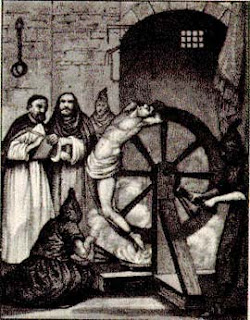While the word dungeon, brings to mind underground places--and indeed in many places they were, the word is originally derived from donjon, a French term for Tower--which is above ground. Throughout history, most prisoners were kept, in actual towers cells, however the most famous and immortalized are those dark, decrepit underground cells.
It has been said that the underground cells were occupied by those who would spend the remainder of their lives there, while tower cells were reserved for those who would be quickly executed, or set free.
As terrifying as it may have been to be, taken to the Tower of London--shoved in a cell with no idea if you should live or die--at least you might have had a glimpse of the outside through a window... or not... No, it may be the case that you would be taken to "Little Ease," the infamous dungeon of torture within the Tower of London's White Tower. There is a cell at the bottom, just four feet by four feet, so you can not stand, but neither can you lay flat. Not only would this grow extremely uncomfortable for your body--but would also wreak havoc with your mind.
 In Carlisle Castle--first built by William II, the son of William the Conqueror, the dungeon is famous for its "licking stones." These stones collected enough moisture to keep prisoners alive, by licking them--that is until they were executed on Gallows Hill. (click HERE to see pics)
In Carlisle Castle--first built by William II, the son of William the Conqueror, the dungeon is famous for its "licking stones." These stones collected enough moisture to keep prisoners alive, by licking them--that is until they were executed on Gallows Hill. (click HERE to see pics)Most torture was performed in the dungeons--which in my mind, most resembles a hell for the living. Here you would be racked--your body stretched until your sockets pulled out, your muscles tore, maybe flesh ripped and bones were broken. Perhaps your fingers would be crushed one by one with a thumbscrew. Or your fingernails ripped off one by one. Hot pokers might burn your flesh. You may be whipped, or drowned. In any case, your stay would not be pleasant... pleasant would be for you to take your last breath.
In some of my works--mostly my medieval romances and my Tudor-era historical fiction (all of which have yet to be published--but soon, dear readers, soon!)--I make mention of dungeons, towers, prisons, oubliettes, mostly because the threat of death, of imprisonment was very real, especially for nobles and courtiers. Factions pitted against factions, one lord seeking revenge on another, someone scorned, someone jealous, someone wanting what you had, being born to the wrong parents... all of those things could lead to your death, and there was little you could do about it.
I've visited many dungeons in Ireland and France. They were eerie, they were haunting, they left me breathless, and my mind whirling. Have you ever visited a dungeon? Have you put any dungeons into your work? Tell us about it!
*****
Eliza Knight is a multi-published author in historical romance, erotic romance, historical fiction, non-fiction and middle-grade mystery. Visit her at http://www.elizaknight.com/ (romance/erotic romance and non-fiction writing craft), http://www.historyundressed.blogspot.com/ (Historical blog), http://www.authormichellebrandon.com/ (historical fiction) or http://www.mleighingles.blogspot.com/ (middle-grade mystery fiction).








